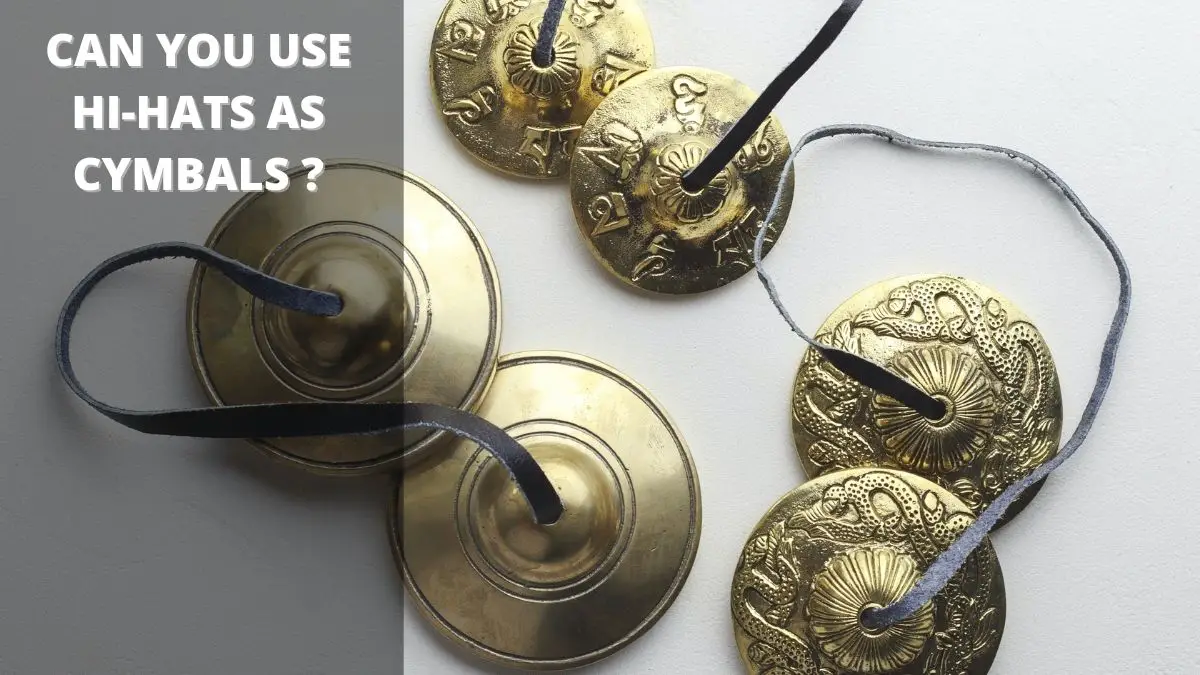Hi-hats are percussion instruments that have been used in traditional and popular music for centuries. Though they are most commonly associated with the percussion section of a band, hi-hats can be used as cymbals in a number of different ways.
These have a rim that is placed close to the head of the drum, typically between 18 and 24 inches from the head. They are played by striking the top of the hat with a stick or hand.
Hi-hats can be played open or closed, and can be hit with either the hand or an implement such as a drumstick. Hi-hats are commonly used as cymbals in the percussion world, but can you actually use them for that purpose?
Can You Use Hi-Hats as Cymbals? The answer is yes. Despite their name, hi-hats can also be used as cymbals. Hi-hat cymbals have a thinner metal than traditional cymbals and are played by tapping them with a finger or palm. However, they can also be played using a crash cymbal, which is much easier to control.
Hi-hats as cymbals advantages
Hi-hat cymbals have a few advantages over other cymbals types.
- They are the most common type of cymbal and offer a variety of sounds and tones. They provide a natural, room-filling sound that can be used for a variety of applications.
- They are also versatile, being able to be played with both hands or as part of a drum set.
- It can be used for a variety of percussion rhythms, making them an essential part of any drummer’s toolkit.
- The use of hi-hat cymbals is also essential in various music genres and, as such, is often used by more experienced drummers. For example, hi-hat cymbals are often used in jazz, rock, and pop music. Hi-hat cymbals are also very commonly seen in drum corps and marching band groups.
- They are usually less expensive than other cymbals, they can be used in a wider range of songs, and they create a more consistent sound. It also makes them an affordable option for beginners and professionals alike.
- Additionally, because hi-hats are smaller than other cymbals, they can be used on top of other instruments to create more sonic variety.
- Hi-hat cymbals also have a longer sustain than other cymbals, making them ideal for creating accents or sustained notes. Lastly, hi-hat cymbals are often less expensive than other types of cymbals, making them an affordable option for beginners and professionals alike.
Should I put reverb on hi-hat cymbals?
Sometimes called “the world’s most important drum sound,” the hi-hat cymbal is crucial in creating a solid foundation for your drumming.
However, many drummers overlook the reverb effect they can apply to their hi-hat cymbals to create a unique sound. Whether you’re a drummer in a rock band or simply looking to add some extra depth and dimension to your cymbals, adding reverb can be a great way to improve your sound.
But is reverb necessary on hi-hat cymbals? Here are a few reasons why you might want to consider using it.
- Hi-hat cymbals can provide an interesting and unique sonic character when used in the right context. When played dry, they can have a very thin and crisp sound, but adding some reverb will give them more body and weight, making them more versatile for heavier styles of music.
- Reverb gives your hi-hat cymbals a more spacious sound, which can help make them more dynamic and impactful when played loudly.
- Reverb can make your hi-hat cymbals sound more like a real drum by giving them a more natural and realistic sound, which will help you get the most out of any recording.
- Hi-hat cymbals are a great way to add some sparkle and texture to your drum set. That being said, not all hi-hat cymbals sound the same. I would recommend getting two or three different types of high hats for your kit.
Can you use crash cymbals as hi-hats?
Crash cymbals can be used as hi-hats in a few different ways. They can provide a louder sound than other types of drums, and they’re popular among rock and metal bands.
You can hold them like normal crash cymbals and hit them with your hand or a drumstick. You can also use them as an auxiliary snare drum by mounting them on the side of your snare drum. You can also attach them to a stand and use them as regular crash cymbals.
How tight should the hi-hat cymbal clutch be?
Hi-hat cymbals can be adjusted to provide an incredibly tight or lose grip, but how tight should the hi-hat cymbal clutch be?
Many experienced drummers use a “cymbal” setting on their hi-hat pedal, which means the hi-hat cymbal clutch is set at its tightest. The tighter the cymbal, the more clang on the sound.
However, it is recommended that you experiment to find what feels best for you and your kit. A loose clutch allows the hi-hat cymbal to ring more freely, providing a more vibey sound. A too-tight clutch, on the other hand, can cause the cymbal to hit harshly and produce a less desirable sound.
Does the hi-hat cymbal stand affect sound?
Hi-hat cymbal stands are a common piece of equipment in any drum kit, and for good reason.
A hi-hat cymbal can affect the sound of the drum by creating a more or less muted tone. This is why it’s essential to know what type of hi-hat stand you’re using before you pick up your instrument.
There are three popular types of hi-hat stands- floor, crash, and rack.
- Floor stands are the most popular and common type of hi-hat stand. They are made to rest on the floor, so they provide a very secure base for the cymbal.
- Crash stands have no base, which is why they’re also very popular.
- Rack stands are a relatively new and exciting type of hi-hat stand. They allow you to set up your cymbals on top of a rack, or in the case of the crash stand, they can also be placed directly on the floor.
Conclusion
It is possible to use hi-hats as cymbals. However, it is important to be aware of the difference in sound and technique when using them in this way. Experiment with different techniques and sounds to find what works best for you.


